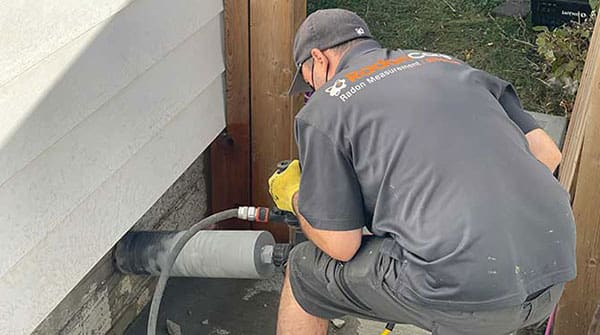Radon gas exposure in rural communities is 30 percent higher than in urban centres, posing a greater threat of lung cancer
 In 2022, research from the Canadian Partnership for Tomorrow’s Health made the surprising observation that one in five (or more) Canadian lung cancers are diagnosed in people who have never smoked tobacco. Ever.
In 2022, research from the Canadian Partnership for Tomorrow’s Health made the surprising observation that one in five (or more) Canadian lung cancers are diagnosed in people who have never smoked tobacco. Ever.
For many, it is equally surprising to learn that another one in five cases of lung cancer arises in Canadians who smoked tobacco so little or so long ago that they are ineligible for current lung cancer screening.
These statistics are not exclusive to Canadians. Even by the late 2000s, researchers found that lung cancer among people who do not use tobacco emerged as the seventh leading cause of cancer-related deaths globally.
According to the Canadian Cancer Society (CCS), the non-tobacco causes of lung cancer include radioactive radon gas exposure, combustion particulates in air pollution (think forest fire smoke or vehicle exhaust), heavy metals such as arsenic, and sources of chronic lung inflammation such as asbestos or infectious diseases including tuberculosis.
According to the recently updated Encyclopedia of Toxicology, radioactive radon is the most prevalent cause of lung cancer after smoking tobacco. Radon, while invisible to human senses, is a significant indoor air health issue driven by building practices that have worsened radon gas’s unnatural accumulation and concentration to hazardous levels within our homes.
Research indicates that one in 10 typical residential houses built after the Second World War exceeds Health Canada’s radon action level of 200 Bq/m³, and these risks have increased as our building codes have evolved.
In 2021, the Khan and Pearson study found that Canadian single detached residential properties built in the 2020s contain historic high radon levels, with one in three exceeding 200 Bq/m³ radon and containing 72 percent higher levels compared to mid-20th century counterparts.
Over the same time, age-adjusted lung cancer rates in Canada rose to 163 percent greater than other cold-climate nations such as Sweden, despite both countries having roughly 12 percent tobacco smoking rates and comparable population demographics.
A major difference between the two countries is that newly constructed property in Canada today has radon levels that are 467 percent higher than those of a similar building in Sweden. While Swedish levels have decreased steadily, Canadian levels have risen over the same period.
Furthermore, different communities experience varying levels of indoor air radon exposure. Homes in more rural (less populated) areas show higher radon levels than those in the already elevated levels in urban centres. The reasons for this have remained relatively unclear until now.
Over the past three years, researchers have investigated the differences in residential radon exposure across Canada between cities, large towns, small towns, and villages, as well as rural homes in hamlets, villages, and isolated areas.
They found that people in rural communities experienced 30 percent greater residential radon exposure than urban populations. This was true for homes in all provinces and territories.
The team determined that the ‘excess’ radon gas in rural communities originated from two factors, one minor and one major:
- The minor factor was that, like the rest of the world, Canadian rural communities tend to have more single-storey, detached houses with larger floor plans, a housing style known to retain higher radon versus multi-storey or multi-family dwellings.
- The major factor was that houses in rural communities are more often situated near one, and in many instances, several drilled groundwater wells.
After ruling out the well water itself as the source of high radon, researchers discovered that the long, thin column of space between the borehole and the well (pipe) acts as an unintended channel, allowing gas rich in radon from deep underground to move into the upper soil layers more readily than it would in the absence of the well.
While the risks of increased radon gas exposure are more significant in rural Canada, the good news is that there are permanent, proven solutions to address the issue without the need to modify groundwater wells: instead, simply block radon from infiltrating homes. In Canada, trained and certified professionals from the Canadian National Radon Proficiency Program (C-NRPP) can facilitate reductions in radon levels.
The bottom line is no matter where you live in Canada, you can ‘Evict Radon’ from your home. The first step is to test for it.
Aaron Goodarzi is a cancer researcher at the University of Calgary and the scientific director of the Evict Radon National Study.
For interview requests, click here.
The opinions expressed by our columnists and contributors are theirs alone and do not inherently or expressly reflect the views of our publication.
© Troy Media
Troy Media is an editorial content provider to media outlets and its own hosted community news outlets across Canada.


